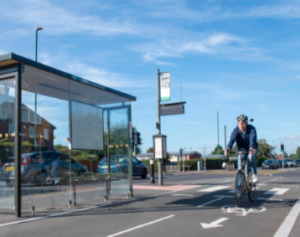One of Liverpool’s most well-known roads-The Strand-is to get a ‘eco-friendly’ redesign next week.
The Strand runs past the historic Royal Albert Docks, Liverpool ONE and Three Graces, is to undergo a £22m upgrade to help reduce congestion and improve safety and air quality.
This will include creating a permanent segregated cycle lane to connect the south of Liverpool to the north, allowing cyclists to eventually ride the full length of the Mersey from Otterspool to Southport. Plans are also being developed to ensure the city’s new 65-mile pop-up cycle lane network is connected.
New trees and public spaces are also being installed as part of a wider strategy to attract and promote walking in the city centre. The road’s design and layout has not changed since the 1950s and it is often at gridlock during peak times and also has become a ‘hotspot’ for road accidents with four fatalities in the past two years. The redesign also aims to make the Liverpool waterfront more accessible for pedestrians with the removal of a traffic lane in each direction and the closure of traffic junctions on another part of the road.
The project is also central to the city’s Liverpool City Centre Connectivity scheme, which has already seen changes to other main streets and the building of a new coach park.
Specialist highways contractor, Graham has started preparations for the changes and excavation of the central reservation will begin at the beginning of July. This first phase of the scheme is scheduled to complete in September, with the second phase in Spring 2021.
Liverpool City Council said that based on computer modelling, it is estimated car journeys at peak times along The Strand, from the end of Leeds Street in the north to Upper Parliament Street in the south, will be reduced by more than a minute in both directions. It said the significant redesigning of how key junctions are used, including the banning of turns cutting across The Strand, will also ensure traffic flow is more fluid meaning less air pollution, as cars are not stopping starting so frequently.
Preparatory work on the environmental element of the scheme has already begun on The Strand, with the first phase of an environmentally innovative type of tree planting on the central reservation. It is designed to alleviate flooding and will help the city adapt to future climate change.
The newly planted trees take the form of a tree Sustainable Urban Drainage system (SUDs) and will make use of any excess surface water on the carriageway, which will be diverted into the tree pit and tree watering system. The SUDs approach is being used across the city centre in partnership with the Mersey Forest and the Urban Green UP project.
Councillor Sharon Connor, Cabinet Member for Highways, said: “Redesigning The Strand has been a huge task and I’m delighted that after all the feedback from residents and businesses we are now at the point where we can begin the change The redesign of The Strand is critical to making Liverpool city centre fit for the future – safer, cleaner and greener for everyone to enjoy.
“The city has declared a Climate Change Emergency and is working on a Clean Air plan, so being smarter with how we use our major roads is going to make a massive contribution in reducing congestion and therefore the city’s carbon footprint and air quality.”
She added: “The Strand’s safety record is appalling. Four fatalities in the past two years in unacceptable and shows what a hazard it is to pedestrians. By significantly redesigning how the junctions work we can take a lane out and the traffic will still flow better. As a result we can widen the pavements for pedestrians to ensure a safer experience and install a segregated cycle lane.”






















